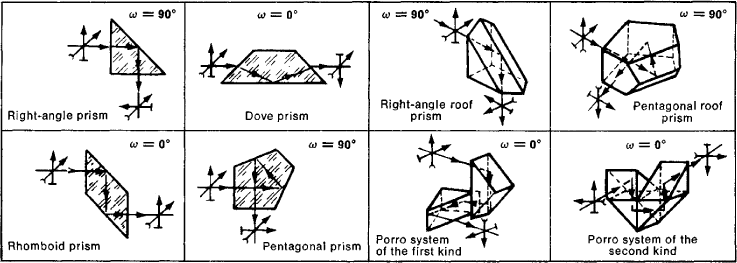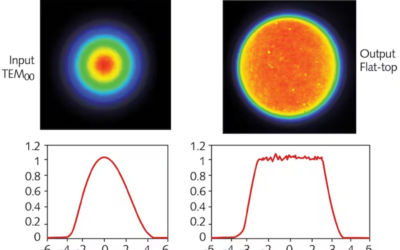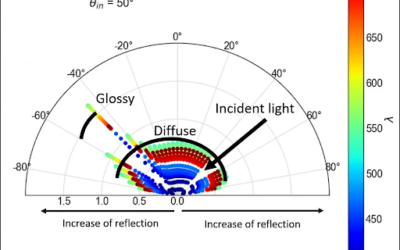One of the most famous images in the history of optics is that of Sir Isaac Newton with a beam of white light going through a glass prism and a rainbow coming out the other side. It is one of the most famous optical experiments, not only for its simplicity, but also because it helped Newton set the foundations for his corpuscular theory of light.
That small prism that Newton was using is just one example of the use of a prism in an optical system. In this article, we will try to describe the four types of prisms: dispersive (like the one Newton was using), reflective, rotative, and displacive. This article with also discuss prism manufacturing.

Dispersive prism
Dispersive prisms
Dispersive prisms, usually in the shape of a triangular prism, are used to separate the different wavelengths of an incident beam of light into different optical paths. Each wavelength will be deflected at a different angle by the prism shape thus changing the refractive index for each wavelength. Flint is a very common glass to manufacture prisms due to its high dependence on its refractive index with respect to the light’s wavelength. Typical application of dispersive prisms can be found in spectroscopy, but they can also be used for laser tuning and beam combining. For more information, please read our article “Dispersive Prisms”
Reflective prisms
Reflective prisms can be used in imaging systems. Due to the total internal reflection, light entering the prism can undergo multiple reflections until they reach an output face. It is possible to add a reflective surface so the prism behaves as a beam splitter. Reflective prisms are used to reduce the physical size of an optical system, to redirect the direction of light, and to reform the orientation of an image.
Reflective prisms present lower optical power losses than equivalent systems made with mirrors and are usually easier to align due to the fact that a single element is used instead of several.
Figure 1 shows one of the most common reflective prisms geometries. In general, if the number of reflective faces is even, we will be creating an upright image, while an even number of reflective surfaces will create an inverted image.

Different types of prisms and configurations
Right angle prisms are usually used to deviate the direction of light by 90-degrees. It’s possible to use a right angle prism in a Porro configuration when light is incident through the prism’s hypotenuse. Light will be deflected 180-degrees and flipped.
Dove prisms are right angle prisms with their top part removed. They can be used to invert images. It is possible to coat the side where light is reflected for optical sensing applications.
Right-angle roof prisms are usually used in binoculars or when a right angle deflection of an image is required. The image is deflected left-to-right not top-to-bottom.
A pentagonal roof prism, deviates the beam 90-degrees without deflection left-to-right or top-to-bottom.
Rhomboid Prisms create an output beam that is displaced from the input beam, but it doesn’t change the direction of the beam, nor does it invert the image.
Porro prisms (either stand-alone or in higher-degrees configurations) are usually used to change the orientation of an image. They are usually used as erectors in optical instruments like binoculars, telescopes, and microscopes where there are space restrictions. The degree of a porro system will depend on how many axes the image needs to be altered in
Wedge prisms: Have a shallow angle and can be used together for beam steering in a Risley prim pair
Anamorphic Prisms
An interesting application of prisms is the change of the incident beam dimensions. This is caused exclusively by the geometry of the prism (e.g. the angle of the incident vs refracted faces), and not the focusing elements or collimating effects like in a lens. Anamorphic lenses are usually configured in pairs to keep the beam traveling along the optical axis.
Manufacturing
The manufacturing of prisms usually involves several steps. Starting with the chosen glass, a series of cuts are done to form a basic prism shape. This stage usually ends in a rough draft of the final product. The prism will have the shape requested but of poor optical performance.
After that, a series of polishing and smoothing steps of the optical surfaces are needed. This can take several iterations depending on the optical tolerances requested by the client and their application. At this stage, antireflection coatings, filters, and metallic layers can be added to achieve the required performance.
A technician is in charge of supervising and evaluating each stage. Some prism geometries can be bought off-the-shelf but for specific applications or custom made optics, it usually requires a considerable amount of time for testing and manufacturing.
Please let us know in the comments if you have had the need to use custom prisms and what was your application.





